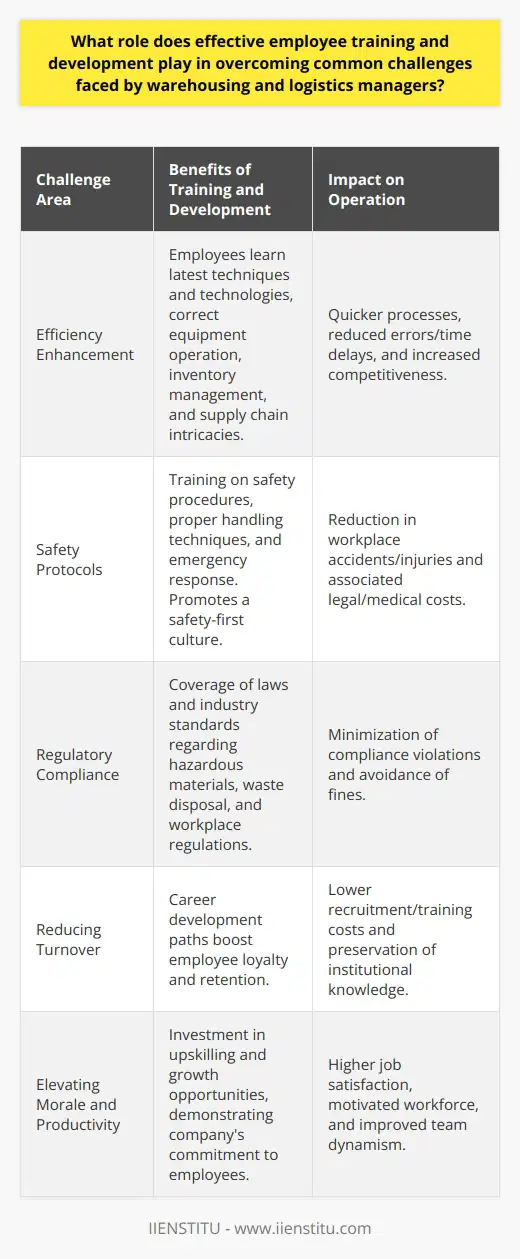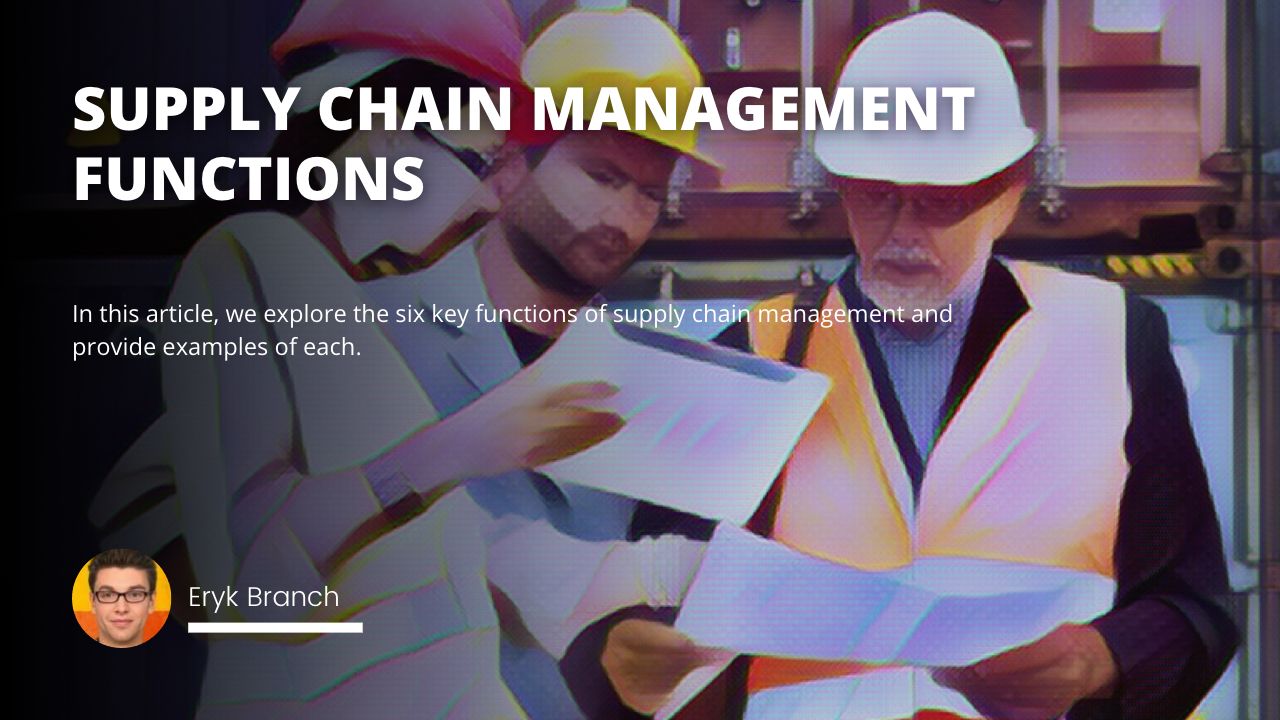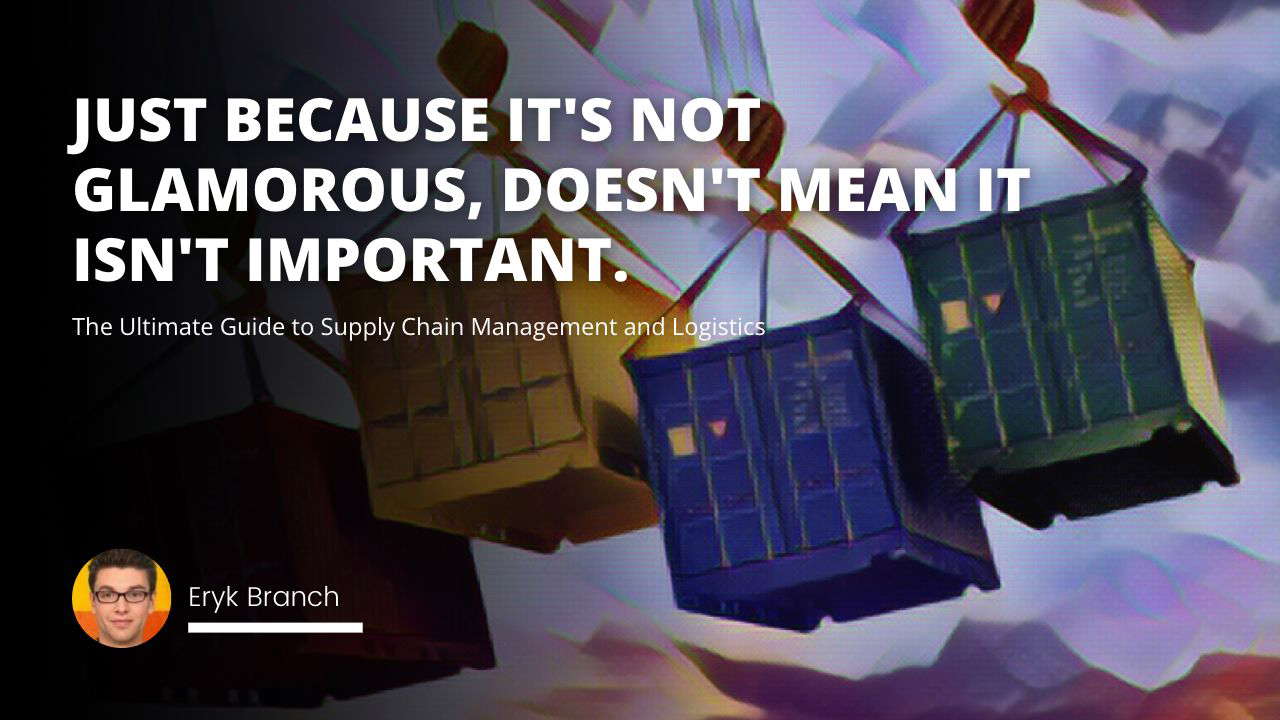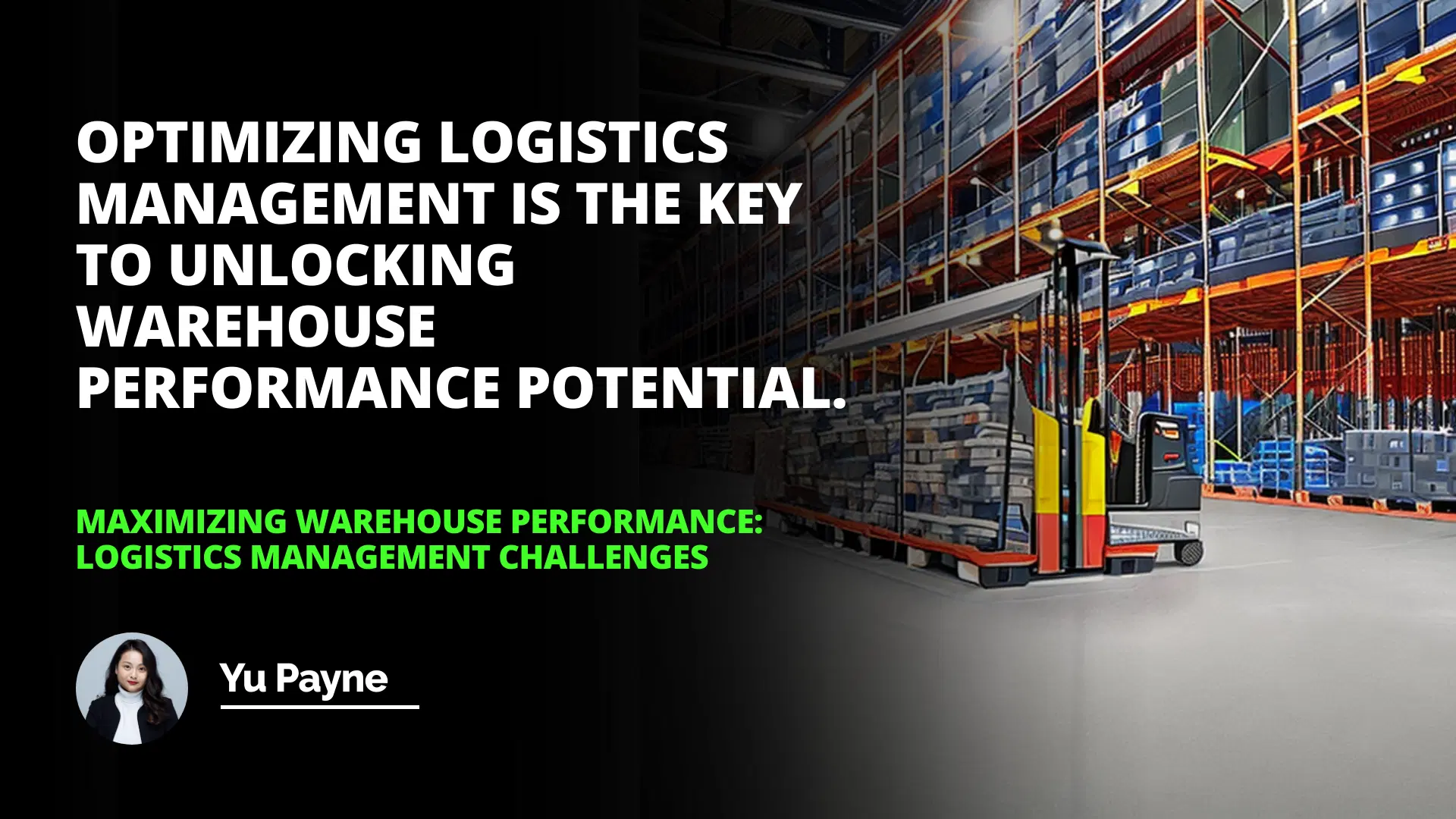
This article discusses the role of the warehouse in the logistical supply chain, the importance of performance evaluation for Warehouses, and how space utilization and automation can be used to maximize performance.
Warehouses provide a place for goods to be stored and organized and are essential for the efficient and effective movement of goods and services. Performance evaluation is necessary to ensure that the warehouse can meet the needs of the supply chain, and space utilization and automation can help to reduce costs and increase productivity. By utilizing space and automating processes, warehouses can maximize performance and meet the needs of the supply chain.
Introduction
The Role of the Warehouse in the Logistical Supply Chain
Performance Evaluation of a Warehouse
Space Utilization and Automation for Maximizing Performance
Conclusion
Introduction: The role of the warehouse in the logistical supply chain is essential for the efficient and effective movement of goods and services. Warehouses provide a place for storing and organizing goods and are often the last stop before goods are shipped to their final destination. With the rise in global competition, the logistical challenge of managing a warehouse is becoming increasingly complex.
Related course: Logistics Management Course
Warehouse performance evaluation is necessary to ensure that the warehouse can meet the needs of the supply chain. Space utilization and automation are two important ways to maximize performance and ensure that the warehouse can meet the needs of the supply chain.
The Role of the Warehouse in the Logistical Supply Chain
A warehouse plays a vital role in the logistical supply chain by providing a place for storing and organizing goods. Warehouses are used to store a variety of goods, including raw materials, finished products, and components.
The warehouse is also a switching facility, allowing goods to be moved from one place to another to meet customer demands. Warehouses also manage inventory, allowing goods to be stored and organized to meet customer needs.
Performance Evaluation of a Warehouse
Performance evaluation of a warehouse is essential for ensuring that the warehouse can meet the needs of the supply chain. Performance evaluation is used to measure the efficiency and effectiveness of the warehouse.
Related course: Supply Chain Management
Performance evaluation is done by measuring the productivity and cost performance of the warehouse. Productivity measures the amount of work done in a given period, while cost performance measures the cost of operating the warehouse.
Space Utilization and Automation for Maximizing Performance
Space utilization and automation are two important ways to maximize performance in a warehouse. Space utilization maximizes the available space in a warehouse to maximize its efficiency.
Automation is using technology to automate specific processes in the warehouse, such as the movement of goods and the tracking of inventory. Automation can help to reduce costs and increase productivity, allowing the warehouse to meet the needs of the supply chain.
Conclusion: In conclusion, the role of the warehouse in the logistical supply chain is essential for the efficient and effective movement of goods and services. Performance evaluation of a warehouse is necessary to ensure that the warehouse can meet the needs of the supply chain.
Space utilization and automation are two important ways to maximize performance and ensure that the warehouse can meet the needs of the supply chain. By utilizing space and automating processes, warehouses can maximize performance and meet the needs of the supply chain.
Optimizing logistics management is the key to unlocking warehouse performance potential.
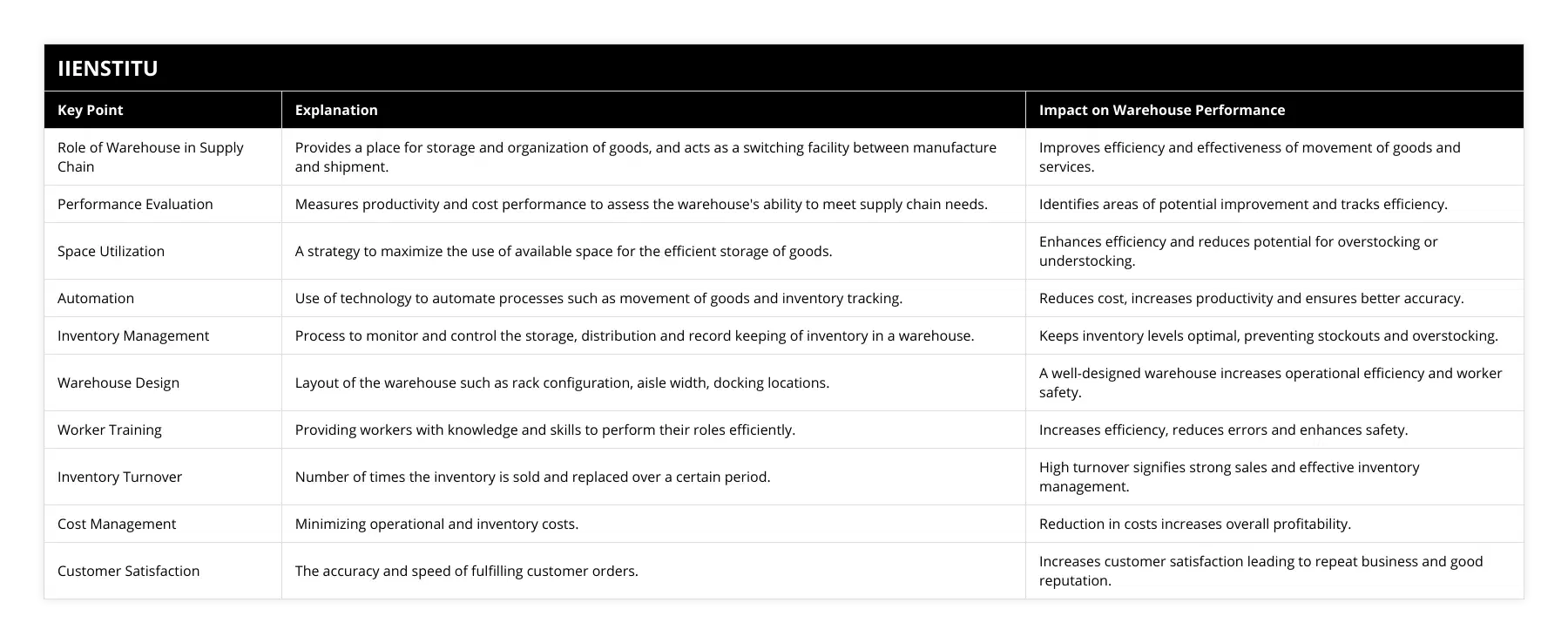
Frequently Asked Questions
What strategies can be used to evaluate the performance of a warehouse?
Evaluating warehouse performance is essential for maintaining efficient inventory and supply chain management. Warehouses play a critical role in the overall success of a business; therefore, it is essential to have a strategy in place to ensure performance is being monitored and assessed. As such, there are a variety of methods and strategies that can be implemented to evaluate warehouse performance.
The first step to evaluating warehouse performance is to establish performance metrics. Some examples of performance metrics include the rate of accuracy, order fill rate, delivery performance, and inventory accuracy.
Once these performance metrics are established, they should be monitored and evaluated to ensure they are met. This can be done by tracking performance data over time and benchmarking it against pre-established targets.
Another strategy that can be used to evaluate warehouse performance is to implement a quality assurance program. This program should ensure that goods are shipped on time, products are adequately packaged, and products are handled safely and securely.
Quality assurance programs can also include inspections of the warehouse facilities, which will help identify any areas needing improvement.
Warehouse performance can also be evaluated through customer feedback. Surveys and customer feedback can provide valuable insight into areas of improvement and help identify areas where performance is lacking. This feedback should inform decisions about changes and improvements that need to be made to the warehouse.
Finally, a warehouse performance review should be conducted regularly. This review should include an analysis of the performance metrics, customer feedback, and quality assurance program results. These results can then be analyzed to identify areas of improvement and create strategies for improving warehouse performance.
In conclusion, there are a variety of strategies that can be used to evaluate warehouse performance. These strategies should include establishing performance metrics, implementing a quality assurance program, and collecting customer feedback.
Additionally, a regular warehouse performance review should be conducted to identify improvement areas and create strategies to improve performance. By implementing these strategies, businesses can ensure that their warehouses operate efficiently and effectively.

How can space utilization be optimized to maximize warehouse performance?
When it comes to warehousing, space utilization is an essential factor in maximizing performance and cost efficiency. To optimize space utilization, warehouse operators must consider the layout of their facility, the type of goods they are storing, and the available staff.
The layout of the warehouse should be designed in such a way that it maximizes the storage capacity of the warehouse. This can be accomplished by using different racks and shelves, such as double-deep shelving, to maximize the use of vertical space.
Additionally, it is essential to ensure that the layout allows for easy access to goods, as this will help reduce the time needed to pick and store items.
In addition to optimizing the warehouse layout, another way to maximize performance is by carefully selecting the type of goods stored in the warehouse. Different types of goods require different types of storage.
For example, fragile or perishable goods need to be stored in temperature-controlled environments for optimal preservation. Additionally, bulky or heavy goods should be stored in a way that is easy to access and move.
Finally, having adequate staff to manage the warehouse is also essential to maximize performance. Having enough personnel to pick and store items and manage inventory can help reduce the amount of time needed to complete tasks.
Additionally, having enough personnel to maintain the facility can help reduce the time needed to repair or replace damaged items.
In summary, proper space utilization is essential in maximizing warehouse performance and cost efficiency. By optimizing the warehouse layout, selecting the correct type of goods to store, and having adequate staff, warehouse operators can ensure that their facility can maximize its performance.

What role does automation play in maximizing warehouse performance?
Automation has become an increasingly important factor in the success of warehouse operations. By utilizing automated systems and processes, warehouses can maximize productivity, safety, and efficiency.
Automation can be used to increase the throughput of a warehouse, reducing the amount of time it takes to complete orders. Automation can also be used to reduce labor costs and improve warehouse operations' accuracy. Automation can also improve safety, ensuring workers are not exposed to hazardous materials or conditions.
Automation can be used to streamline warehouse processes in a variety of ways. Automation can simplify the process of receiving and shipping goods, allowing for more efficient inventory management.
Automated order-picking systems can reduce errors and speed up the order fulfillment process. Automation can also improve labor management, allowing for better employee performance tracking and improved communication between warehouse staff.
In addition to increasing throughput and reducing costs, automation can also be used to improve the safety of warehouse operations. Automated systems can be programmed to monitor warehouse conditions, alerting employees to hazardous conditions or potential accidents.
Automated systems can also be used to monitor the performance of warehouse equipment, preventing breakdowns and minimizing downtime. Automation can also improve the accuracy of warehouse operations, reducing the time spent on returns and ensuring that orders are fulfilled correctly.
Finally, automation can be used to reduce the cost of warehouse operations. Automation can reduce the labor needed to complete tasks, allowing warehouses to hire fewer employees and reduce overall labor costs.
Automation can also be used to improve the accuracy of inventory management, reducing the amount of time spent on manual inventory checks and reducing the amount of product that is lost or damaged.
In conclusion, automation has a significant role in maximizing warehouse performance. Automation can increase a warehouse's throughput, reduce labor costs, and improve warehouse operations' safety and accuracy.
Automation can also be used to reduce the cost of warehouse operations, allowing warehouses to hire fewer employees and reduce their overall labor costs. By leveraging automation, warehouses can maximize performance and improve their profitability.
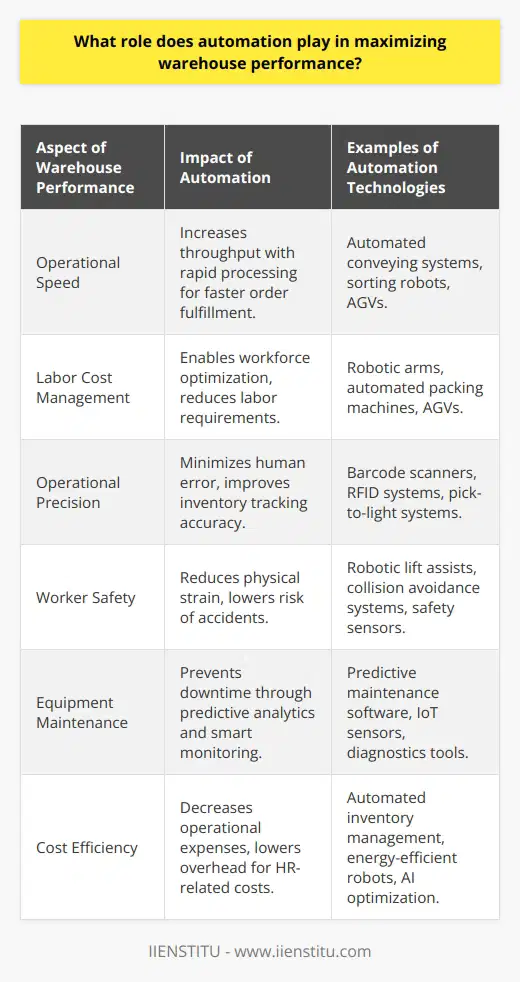
What are the challenges of warehouse in logistics and how do they impact overall supply chain efficiency?
Challenges in Warehouse Operations
One of the primary challenges warehouses face in logistics is maintaining optimal space utilization. Inefficient space utilization can lead to increased operating costs, reduced storage capacity, and difficulties in managing inventory accurately. Moreover, inadequate warehouse layout design and racking systems may hinder stock rotation and negatively impact the overall supply chain efficiency.
Impact of Inventory Management
Another significant challenge in warehouse management is maintaining appropriate inventory levels. Excess stock may not only occupy valuable warehouse space but also increase the risks of obsolescence and slow turnover. On the other hand, inadequate inventory levels could potentially lead to stockouts, resulting in delayed deliveries and dissatisfied customers. Consequently, effective inventory management is crucial for achieving high levels of supply chain efficiency.
Adapting to Technological Advancements
The rapid advancements in technology have led to increased implementation of automation and digitization in warehousing operations. However, adopting these advancements can be a challenge for many organizations due to high investment costs, resistance to change, and skill gaps among employees. Nevertheless, leveraging technology is essential for enhancing warehouse efficiency, enabling real-time data visibility, and streamlining operations in a competitive market.
Labor Management and Productivity
Labor management is another challenge that directly affects warehouse operations and overall supply chain efficiency. Ensuring a well-trained and motivated workforce is crucial for efficient warehouse performance. High employee turnover rates, ineffective labor scheduling, and insufficient training can significantly impact productivity, leading to decreased throughput rates and increased costs.
Safety and Regulatory Compliance
Warehouses also face the challenge of adhering to safety regulations and maintaining a safe working environment for employees. Failure to comply with safety standards can result in workplace accidents, losses due to damages, and potential legal consequences. In addition, continuously updating and implementing safety measures is essential to maintaining a hazard-free workplace, contributing to overall supply chain efficiency.
In conclusion, challenges like space utilization, inventory management, technological advancements, labor management, and safety compliance are critical aspects of warehouse operations that directly impact overall supply chain efficiency. Addressing these challenges, adopting best practices, and investing in advanced technologies can help improve warehouse performance and contribute to a more efficient and effective supply chain.

How does a comprehensive warehousing management strategy address common issues and challenges faced in the industry?
Efficiency in Warehousing Management
A comprehensive warehousing management strategy effectively addresses various issues and challenges in the industry by prioritizing efficiency. This approach streamlines processes, optimizes the use of available resources, and reduces errors, ultimately leading to cost and time savings.
Utilization of Technology
Warehouse management systems (WMS) are key components of a comprehensive strategy. These systems facilitate the collection, storage, and analysis of data, allowing for accurate tracking, monitoring, and optimization of warehouse operations. By leveraging WMS, businesses can make informed decisions on resource allocation, order prioritization, and inventory control, thus mitigating risks associated with instances such as overstocking or stockouts.
Optimization of Storage Space
An effective warehousing management strategy prioritizes space optimization. By implementing storage solutions such as racking systems and modular shelving, warehouses can increase capacity while maintaining an organized layout. This reduces the time spent searching for specific items and allows for a smoother flow of operations, minimizing the likelihood of bottlenecks and delays in the order fulfillment process.
Adoption of Lean Principles
The integration of lean principles within warehouse operations aids in addressing challenges related to cost and time management. Waste elimination, continuous improvement, and standardization are key principles that, when applied effectively, can streamline processes, enhance worker productivity, and promote overall operational efficiency. By adopting lean principles, warehouses can effectively manage resources and identify areas for improvement.
Focus on Workforce Development
Developing the warehouse workforce is crucial for addressing industry challenges. Comprehensive strategies encompass training programs, performance evaluations, and employee engagement initiatives to ensure workers possess the necessary skills and motivation to excel in their roles. By investing in workforce development, warehouses can achieve higher levels of employee satisfaction, reduced turnover, and increased productivity.
Conclusion
In summary, a comprehensive warehousing management strategy addresses common issues and challenges in the industry by focusing on the optimization of technology, storage space, lean principles, and workforce development. This holistic approach promotes efficient warehouse operations, ultimately leading to cost and time savings.
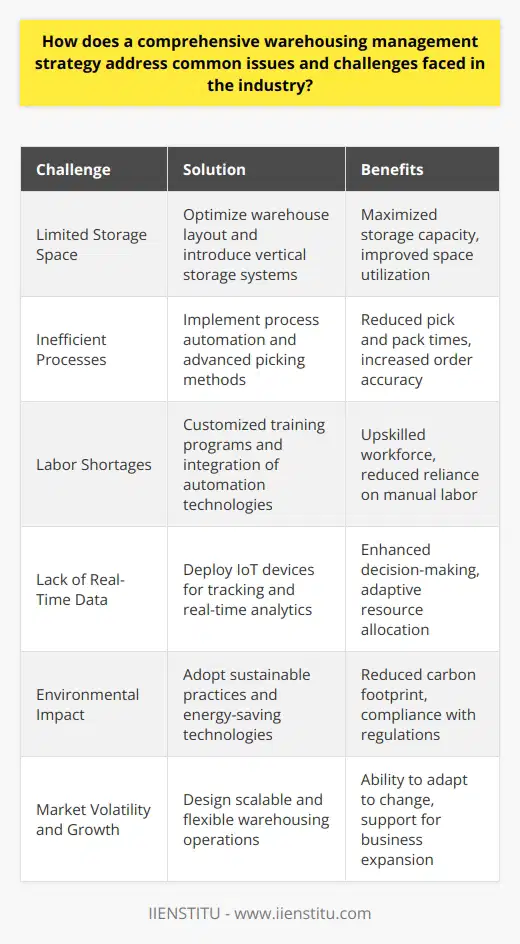
What are the key steps towards optimizing warehouse performance and maximizing efficiency through effective space utilization, automation, and process improvement?
Effective Space Utilization
The first step towards optimizing warehouse performance is effective space utilization. This involves analyzing the warehouse layout to identify and eliminate wasted space, optimizing the storage system by using appropriate racking and shelving solutions, adjusting aisle widths to accommodate material handling equipment, and strategically positioning inventory to ensure fast and easy access.
Automation Integration
Integrating automation into warehouse operations is another crucial step in maximizing efficiency. Automated storage and retrieval systems (AS/RS) enhance storage density, eliminate human errors, and facilitate real-time inventory tracking. Similarly, implementing conveyor systems and robotic material handling solutions can streamline the movement of goods, reduce response times, and minimize labor costs.
Process Improvement
Lastly, refining operational processes plays a vital role in optimizing warehouse performance. Employing lean methodologies can help streamline workflows, minimize waste, and enhance overall efficiency. Additionally, the use of advanced data analytics and warehouse management systems (WMS) can provide actionable insights, enabling organizations to make informed decisions, predict potential bottlenecks, and optimize resource allocation.
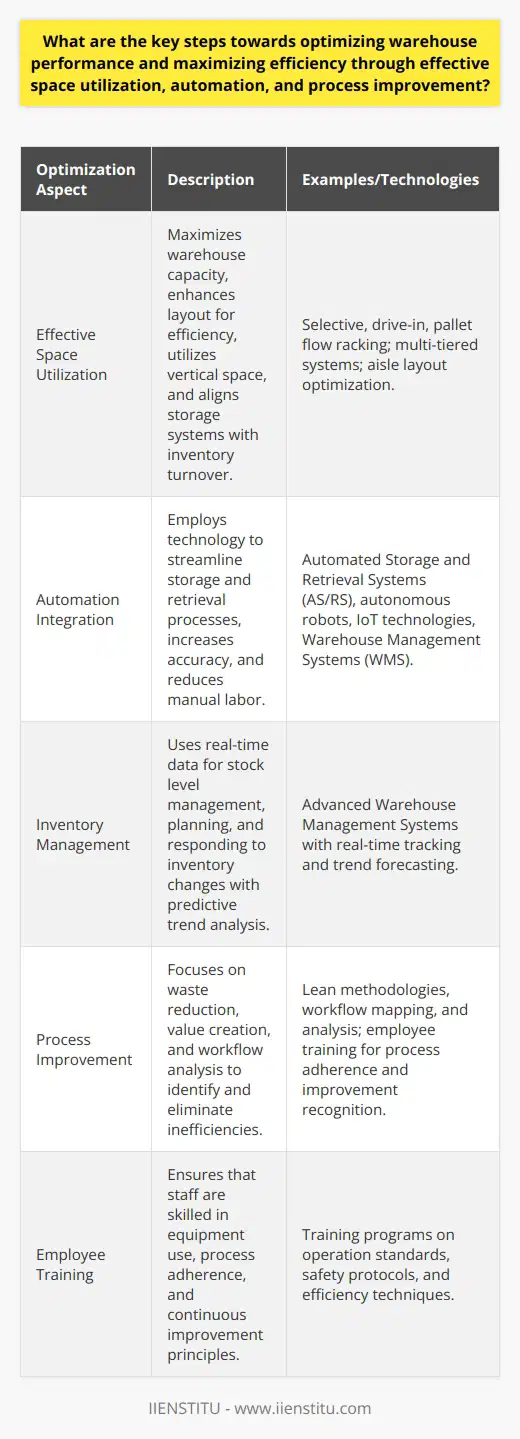
What are the essential components of an effective warehouse performance optimization strategy?
Essential Components of Warehouse Optimization
Warehouse Layout and Design
An effective warehouse performance optimization strategy must involve a well-designed layout that maximizes the use of space while minimizing travel distances for order pickers. This can be achieved through strategic placement of storage racks, material handling equipment, and workstations, ensuring that high-demand items are easily accessible.
Inventory Management
Proper inventory management is crucial to warehouse optimization. Accurate tracking and forecasting of stock levels can help maintain an appropriate balance between supply and demand, preventing excessive inventory costs and stockouts. This often involves the use of specialized software and technology, such as warehouse management systems (WMS) and automated trackers.
Warehouse Automation
Integrating warehouse automation technology, such as automated storage and retrieval systems (AS/RS), conveyor systems, and robotic pickers, can greatly improve operational efficiency. Automation technology can streamline processes, reduce labor costs, and minimize errors, ultimately leading to greater productivity and cost savings.
Employee Training and Incentives
Well-trained employees who understand the goals of optimization efforts are more likely to effectively execute warehouse operations. Implementing ongoing employee training programs and offering performance-based incentives can encourage a culture of continuous improvement and increased productivity.
Performance Metrics and Analytics
Implementing performance metrics and analytics is essential to track the success of the optimization efforts. Key performance indicators (KPIs) such as order picking accuracy, inventory turnover, and order fulfillment rates can provide valuable insight into the efficiency of warehouse processes. Utilizing data analytics can help identify areas for improvement and enable informed decision-making.
Continuous Improvement
Lastly, an effective warehouse performance optimization strategy should be a continuous process, involving regular assessment and adjustment of various elements in response to changes in demand, market conditions, and technological advancements. This iterative approach ensures that the warehouse remains flexible, adaptive, and optimally efficient in the long run.
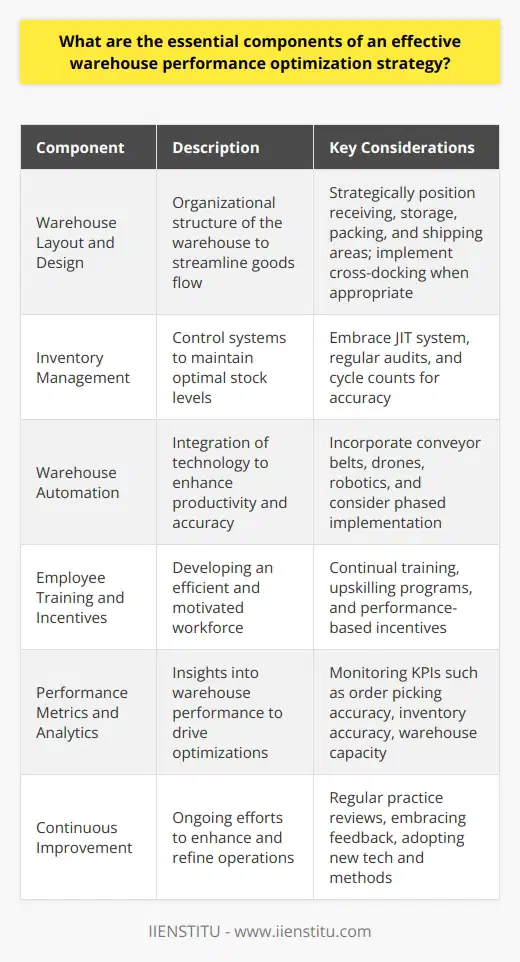
How do warehouse management systems contribute to overcoming common challenges in the warehousing and logistics sector?
Effective Inventory Management
Warehouse management systems (WMS) play a crucial role in addressing the common challenges faced in the warehousing and logistics sector. One of the key contributions of WMS is effective inventory management. By utilizing advanced tracking technologies such as radio frequency identification (RFID) and barcoding, these systems provide real-time data on inventory levels, locations, and movement. This enables organizations to maintain accurate stock records, reduce instances of stockouts or overstocking, and streamline order fulfillment processes, resulting in improved customer satisfaction.
Efficient Space Utilization
Another significant advantage of WMS is the optimization of warehouse space. The systems enable the efficient use of available space by applying intelligent storage and retrieval strategies. These include implementing various storage techniques like slotting, which places items based on demand, and employing automated storage and retrieval systems (AS/RS) that can navigate the warehouse and access stored goods with minimal human intervention. Consequently, this increases storage densities, reduces the time spent on material handling tasks, and promotes overall operational efficiency.
Enhanced Labor Productivity
WMS contributes to improved labor productivity through better workforce planning and task allocation. The system allows managers to optimally schedule employees and assign tasks based on their skillsets and availability. Furthermore, WMS employs a data-driven approach to evaluate worker performance and identify areas for improvement. By incorporating real-time monitoring and performance metrics, these systems facilitate data-driven decision-making that supports the continuous development of workforce efficiency.
Error Reduction and Improved Accuracy
Implementing WMS helps in minimizing errors that arise from manual processes such as data entry, counting, and tracking inventory. The automation of these processes offers a higher degree of accuracy, reducing the likelihood of mistakes. For example, by using a barcode scanning system, warehouse personnel can quickly and accurately confirm the receipt and shipment of goods, leading to enhanced data accuracy and streamlined operations.
Cost Savings and Increased Profitability
The cumulative benefits of WMS – ranging from optimized inventory control and space utilization to improved labor productivity and reduced errors – ultimately contribute to cost savings for warehousing and logistics organizations. By streamlining various processes and leveraging data-driven insights, firms are better positioned to make strategic decisions that enhance profitability. Furthermore, the ability of warehouse management systems to facilitate just-in-time (JIT) inventory practices enables companies to adopt leaner operations that minimize waste, ultimately contributing to higher profit margins.
In conclusion, warehouse management systems offer a comprehensive solution to overcoming common challenges in the warehousing and logistics sector. By addressing critical aspects like inventory management, space utilization, labor productivity, and error reduction, these systems provide indispensable tools and insights that enhance operational efficiency, improve customer satisfaction, and ultimately support higher profitability for these organizations.

What role do emerging technologies and innovations play in addressing the key challenges faced by warehouse and logistics managers?
Role of Emerging Technologies in Problem-solving
Emerging technologies and innovations play a vital role in addressing the critical challenges faced by warehouse and logistics managers. These challenges often include space utilization, labor shortages, cost management, and delivery optimization.
Efficient Space Utilization
Innovative technological solutions enable better space utilization in warehouses. For instance, the use of autonomous mobile robots (AMRs) and three-dimensional racking systems enhances the storage capacity while maintaining an organized inventory system.
Mitigating Labor Shortages
Warehouse automation using robotics technology addresses labor shortages and human resource issues. Automated Guided Vehicles (AGVs) and collaborative robots support workers in performing repetitive tasks, increasing operational efficiency, and reducing physical strain on employees.
Cost Management Strategies
Innovative technologies aid in reducing operational costs through energy-efficient solutions and data-driven analytics. For example, using Internet of Things (IoT) devices and advanced software systems, managers can monitor and control energy consumption, optimize the maintenance of equipment, and minimize resource wastage.
Delivery Optimization
Emerging technologies such as artificial intelligence (AI) enable logistics managers to analyze vast amounts of data to streamline transport routes and optimize delivery schedules. This can result in reduced fuel consumption, lower carbon emissions, and timely deliveries to clients.
Enhanced Visibility and Control
Technologies such as real-time inventory tracking systems, Warehouse Management Systems (WMS), and Blockchain applications can improve transparency, data accuracy, and secure sharing of information within the supply chain. This enhanced visibility leads to better decision-making and increased control over inventory management and logistics.
In conclusion, emerging technologies and innovations play a vital role in overcoming the key challenges faced by warehouse and logistics managers. By incorporating these solutions, organizations can enhance their operational efficiency, reduce costs, and meet customers' ever-evolving demands.
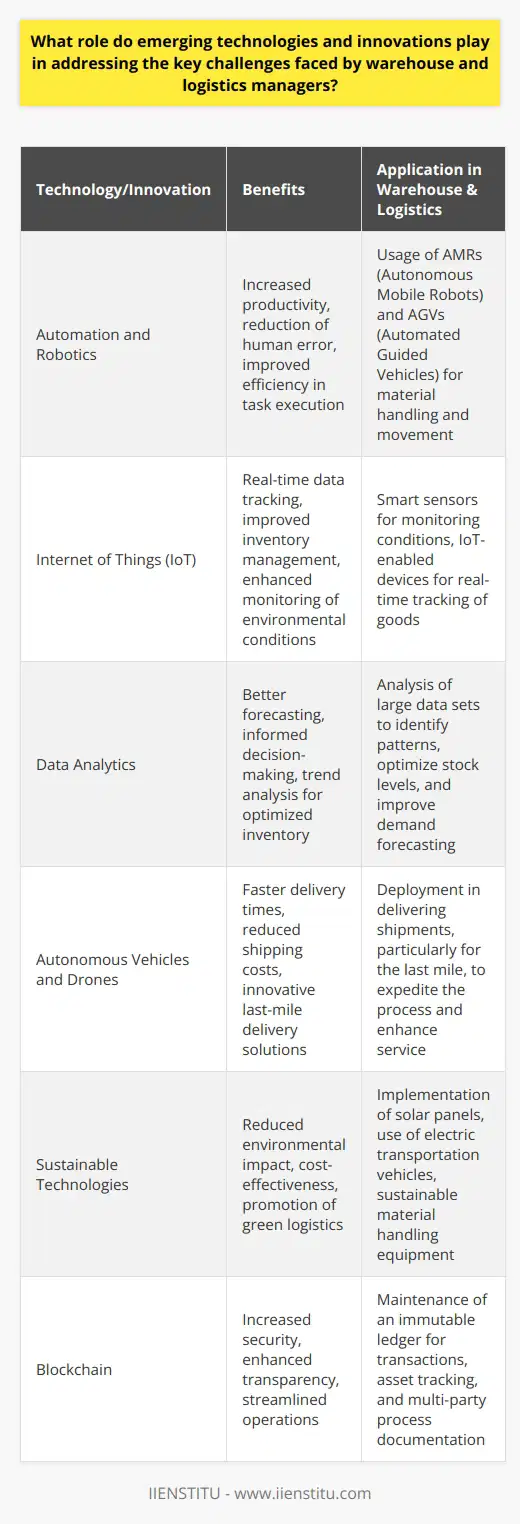
What are the main factors influencing warehouse efficiency and how can they be effectively addressed to optimize performance?
Key Factors
The core drivers for warehouse efficiency are inventory management, warehouse layout, use of technology, and workforce efficiency.
Inventory Management
Poor inventory management leads to overstocking and understocking which both create inefficiencies. To tackle this, warehouses should invest in real-time inventory tracking systems to maintain an accurate insight into stock movements. This will ensure timely reordering to avoid costly out-of-stock or overstock situations.
Warehouse Layout
The layout of a warehouse significantly influences its efficiency. Poorly arranged items can necessitate longer retrieval times and higher operational costs. Warehouses should consider implementing slotting optimization strategies to ensure a logical, streamlined layout. Additionally, regular audits of warehouse space usage can identify any areas of waste, enabling more efficient utilization.
Technology Implementation
Technology is another factor that can enhance or impede efficiency. The adoption of automated systems can remove manual tasks, increasing speed and reducing errors, leading to significant performance improvements. Warehouse management systems (WMS) can automate inventory tracking, picking and packing processes, and employee tasks, significantly boosting efficiencies.
Workforce Efficiency
The efficiency of a warehouse workforce directly influences overall productivity. Providing staff with ongoing training and performance information can boost productivity. The use of labor management systems (LMS) can also provide valuable insights and identify areas for improvement, enabling management to address performance issues proactively.
In summary, warehouse efficiency is driven by the correct management of inventory, effective use of space, the implementation of appropriate technology, and efficient workforce management. These areas can be effectively addressed through the adoption of real-time inventory tracking, slotting optimization strategies, automation, and labor management systems.
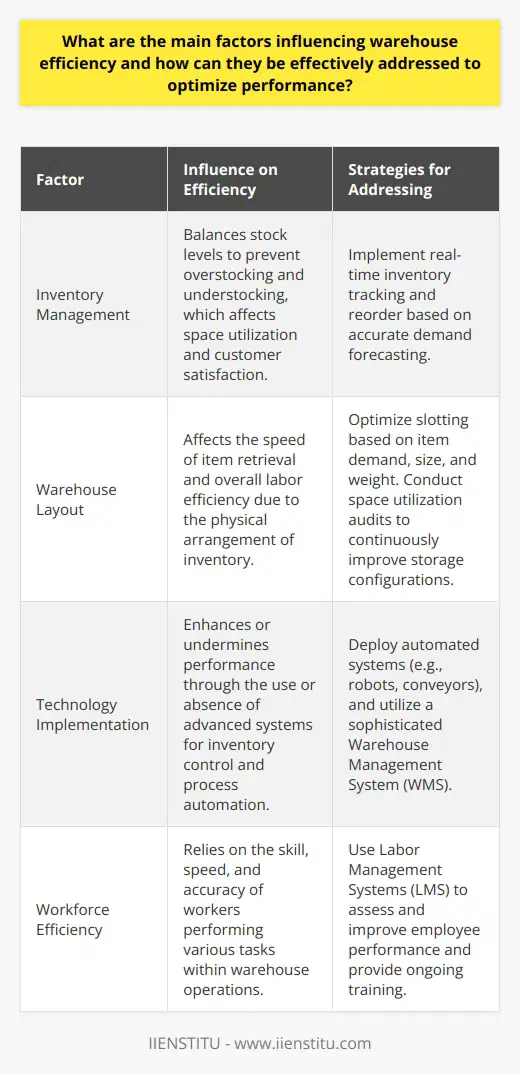
How do warehouse layout, organization, and material handling approaches impact overall warehousing and logistics efficiency?
Layout Influence
The layout of a warehouse significantly affects efficiency. Effective design minimizes movement, simplifying processes and reducing labor needs. It eliminates wasted space, enhancing storage capacity and productivity.
Storage Organisation
Storage organization in a warehouse also impacts efficiency. Proper arrangement and classification of goods streamline inventory management. It also simplifies storage and retrieval processes, reducing time and effort.
Material Handling Approaches
Material handling approaches entail strategies used in moving, protecting, storing, and controlling materials in a warehouse. The right handling techniques accelerate operations, reducing manual labor and enhancing accuracy.
Technology Integration
Integrating technology into warehousing also improves efficiency. Automated systems, robotics, and mobile solutions streamline operations, reduce errors, and enhance data accuracy.
Safety Measures
Enforcing safety measures promotes a conducive working environment. It reduces accidents, protects workers, and decreases downtime often associated with injury and equipment damage.
Optimal Warehouse Layout and Safety Standards
In a well-organized layout conforming to safety standards, workers can move, locate, and deliver goods easily. This setup results in higher delivery speed and order accuracy, improving customer satisfaction.
Conclusion
In conclusion, warehouse layout, organization and material handling approaches significantly influence overall warehousing and logistics efficiency. Therefore, warehouse operators should regularly evaluate and revise these aspects to sustain high productivity and customer satisfaction. These changes can ultimately encourage cost-effectiveness and competitiveness in the logistics industry.

What role does effective employee training and development play in overcoming common challenges faced by warehousing and logistics managers?
Role of Training in Overcoming Warehousing Challenges
Effective employee training and development plays a crucial role in managing the common challenges faced by warehousing and logistics managers. The correct employee training can address issues related to efficiency, safety, and compliance, which are three fundamental concerns for any warehouse.
Increasing Efficiency through Training
Training enables employees to enhance their skills, improving their productivity. With a better understanding of their tasks, employees can execute their duties more efficiently, reducing errors and delays.
Ensuring Safety
Warehousing jobs are often associated with risks. Well-designed training programs focus on safety protocols, reducing workplace accidents. This can decrease liability issues and improve overall operations.
Fostering Compliance
Training also provides an understanding of compliance regulations. Employees aware of sector-specific rules are less likely to violate these regulations, thus mitigating legal implications.
Combatting High Turnover Rates
Warehousing and logistics sectors often face high employee turnover. Training offers employees opportunities for growth, leading to employee retention.
Boosting Morale and Productivity
Continuous development initiatives can add to the job satisfaction of employees. This not only fosters a positive work environment but also enhances productivity.
In conclusion, effective training plays a key role in overcoming the common challenges faced by warehousing and logistics managers. It acts as a catalyst to improve efficiency, ensure safety, foster compliance, lower turnover rates, and boost employee morale and productivity.
